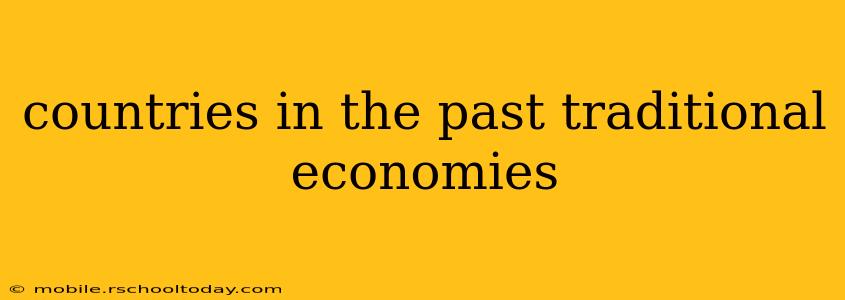Many countries across the globe, particularly in regions like Africa, Asia, and South America, historically operated under traditional economies. These systems, often rooted in centuries-old practices, are defined by their reliance on custom, tradition, and bartering rather than market forces or large-scale industrial production. While few countries today operate exclusively under a traditional economic model, understanding their characteristics provides valuable insight into economic development and the complexities of globalization.
Defining a Traditional Economy
A traditional economy is characterized by several key features:
- Subsistence Farming: Agriculture is the primary economic activity, with most production aimed at feeding the family or immediate community, leaving little for trade or surplus. This often involves relatively simple farming techniques, passed down through generations.
- Limited Technology: Technological advancements are minimal or slow to adopt. Tools and techniques remain largely unchanged over extended periods, contributing to low productivity.
- Bartering and Exchange: Money plays a limited role, with goods and services often exchanged through bartering – the direct trade of goods or services without monetary transactions.
- Strong Social Structures: Social roles and relationships heavily influence economic activity. Family and community ties dictate production, distribution, and consumption patterns.
- Limited Specialization: Individuals and communities tend to perform a limited range of tasks, often dictated by tradition and social standing. Specialization and division of labor are less pronounced.
Historical Examples of Traditional Economies
While pinpointing countries that exclusively operated under a traditional economy in the past is difficult – as even the most isolated societies often had some level of external interaction – several showcase strong elements of this system:
- Pre-Colonial Africa: Many tribes and communities across the African continent, prior to European colonization, relied heavily on subsistence agriculture, bartering, and strong social structures. Specific examples include various groups in the rainforest regions and parts of the Sahel.
- Pre-Industrial Asia: Numerous societies in Asia, particularly in remote or mountainous areas, maintained traditional economies for centuries. Think of certain communities in the Himalayas or Southeast Asia's interior.
- Indigenous Populations Globally: Indigenous communities across the world, often geographically isolated, maintained and continue to maintain elements of traditional economic systems, adapting them to varying degrees in response to globalization.
Transitioning from Traditional to Modern Economies
The shift from a traditional economy to a market or mixed economy is a complex process. This transition is usually driven by factors like:
- Globalization: Increased contact with the outside world exposes communities to new technologies, goods, and market opportunities.
- Technological Advancements: The introduction of new tools and techniques can significantly improve agricultural output and efficiency.
- Government Policies: Government intervention, including infrastructure development, education, and market reforms, can play a vital role in facilitating the transition.
- Urbanization: Movement of populations from rural areas to urban centers leads to increased specialization and the rise of market-based activities.
The Present Day: A Blend of Systems
It's important to note that today, pure traditional economies are extremely rare. Most countries have undergone significant economic transitions, incorporating elements of market or mixed economies. However, many still retain aspects of traditional economic practices within certain sectors or communities. The level of integration into the global economy varies greatly.
Understanding the characteristics of traditional economies provides crucial context for analyzing economic development, poverty reduction strategies, and the challenges faced by developing nations. Studying these historical and contemporary economic structures helps us appreciate the complexity of economic systems and the enduring influence of culture and tradition on economic activity.
